This is a follow-up to my previous question here
I've been trying to convert the color data in a heatmap to RGB values.
In the below image, to the left is a subplot present in panel D of the source image. This has 6 x 6 cells (6 rows and 6 columns). On the right, we see the binarized image, with white color highlighted in the cell that is clicked after running the code below. The input for running the code is the below image. The ouput is(mean = [ 27.72 26.83 144.17])is the mean of BGR color in the cell that is highlighted in white on the right image below.
A really nice solution that was provided as an answer to my previous question is the following (ref)
import cv2
import numpy as np
# print pixel value on click
def mouse_callback(event, x, y, flags, params):
if event == cv2.EVENT_LBUTTONDOWN:
# get specified color
row = y
column = x
color = image[row, column]
print('color = ', color)
# calculate range
thr = 20 # ± color range
up_thr = color + thr
up_thr[up_thr < color] = 255
down_thr = color - thr
down_thr[down_thr > color] = 0
# find points in range
img_thr = cv2.inRange(image, down_thr, up_thr) # accepted range
height, width, _ = image.shape
left_bound = x - (x % round(width/6))
right_bound = left_bound + round(width/6)
up_bound = y - (y % round(height/6))
down_bound = up_bound + round(height/6)
img_rect = np.zeros((height, width), np.uint8) # bounded by rectangle
cv2.rectangle(img_rect, (left_bound, up_bound), (right_bound, down_bound), (255,255,255), -1)
img_thr = cv2.bitwise_and(img_thr, img_rect)
# get points around specified point
img_spec = np.zeros((height, width), np.uint8) # specified mask
last_img_spec = np.copy(img_spec)
img_spec[row, column] = 255
kernel = np.ones((3,3), np.uint8) # dilation structuring element
while cv2.bitwise_xor(img_spec, last_img_spec).any():
last_img_spec = np.copy(img_spec)
img_spec = cv2.dilate(img_spec, kernel)
img_spec = cv2.bitwise_and(img_spec, img_thr)
cv2.imshow('mask', img_spec)
cv2.waitKey(10)
avg = cv2.mean(image, img_spec)[:3]
mean.append(np.around(np.array(avg), 2))
print('mean = ', np.around(np.array(avg), 2))
# print(mean) # appends data to variable mean
if __name__ == '__main__':
mean = [] #np.zeros((6, 6))
# create window and callback
winname = 'img'
cv2.namedWindow(winname)
cv2.setMouseCallback(winname, mouse_callback)
# read & display image
image = cv2.imread('ip2.png', 1)
#image = image[3:62, 2:118] # crop the image to 6x6 cells
#---- resize image--------------------------------------------------
# appended this to the original code
print('Original Dimensions : ', image.shape)
scale_percent = 220 # percent of original size
width = int(image.shape[1] * scale_percent / 100)
height = int(image.shape[0] * scale_percent / 100)
dim = (width, height)
# resize image
image = cv2.resize(image, dim, interpolation=cv2.INTER_AREA)
# ----------------------------------------------------------------------
cv2.imshow(winname, image)
cv2.waitKey() # press any key to exit
cv2.destroyAllWindows()
What do I want to do next?
The mean of the RGB values thus obtained has to be mapped to the values in the following legend provided in the source image,
I would like to ask for suggestions on how to map the RGB data to the values in the legend.
Note: In my previous post it has been suggested that one could
fit the RGB values into an equation which gives continuous results.
Any suggestions in this direction will also be helpful.
EDIT: Answering the comment below
I did the following to measure the RGB values of legend
Input image:

This image has 8 cells in columns width and 1 cell in rows height
Changed these lines of code:
left_bound = x - (x % round(width/8)) # 6 replaced with 8
right_bound = left_bound + round(width/8) # 6 replaced with 8
up_bound = y - (y % round(height/1)) # 6 replaced with 1
down_bound = up_bound + round(height/1) # 6 replaced with 1
Mean obtained for each cell/ each color in legend from left to right:
mean = [ 82.15 174.95 33.66]
mean = [45.55 87.01 17.51]
mean = [8.88 8.61 5.97]
mean = [16.79 17.96 74.46]
mean = [ 35.59 30.53 167.14]
mean = [ 37.9 32.39 233.74]
mean = [120.29 118. 240.34]
mean = [238.33 239.56 248.04]


